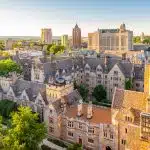The California State Summer School for Math and Science (COSMOS) is a four-week STEM program for high school students in California. Hosted by the University of California (UC) campuses, it lets you explore college-level topics like artificial intelligence, marine biology, and quantum physics. You’ll do hands-on research, work with professors, and meet other students who love science and math as much as you do.
But with a competitive acceptance rate, getting in takes more than just good grades. This guide covers everything: how hard it is to get in, deadlines, requirements, costs, and tips to boost your chances. If you’re serious about STEM, COSMOS could be worth it.
- What Is the COSMOS Summer Program?
- COSMOS Summer Program Acceptance Rate
- COSMOS Summer Program Application Deadline
- COSMOS Summer Program Requirements
- How to Get into the COSMOS Summer Program
- Why Join the COSMOS Summer Program?
- Frequently Asked Questions
- Takeaways
What Is the COSMOS Summer Program?
The California State Summer School for Mathematics and Science (COSMOS) started in 1998. It was inspired by the California State Summer School for the Arts, but instead of focusing on creative fields, it aimed to challenge students in STEM. The first programs launched at UC Irvine and UC Santa Cruz in 2000, followed by UC Davis in 2001, UC San Diego in 2004, and UCLA in 2024.
The COSMOS summer program gives high school students a chance to live on a UC campus, do hands-on research alongside renowned faculty and researchers, and explore advanced STEM topics for four weeks. The 2025 program runs from July 6 to August 1.
The COSMOS summer program runs at five UC campuses:
- UC Davis. Located in Northern California, near Sacramento, this campus is a great option for students in or around the state’s capital.
- UC Irvine. About 40 miles south of Los Angeles, UC Irvine sits near Newport Beach, making it a solid pick for students in Southern California.
- UC Los Angeles. Right in the heart of LA, UCLA offers access to top research labs and industry connections in one of the country’s biggest tech hubs.
- UC Santa Cruz. Perched on the coast, about an hour south of San Francisco, this campus gives students a mix of STEM learning and ocean views.
- UC San Diego. Located in La Jolla, UCSD puts students close to San Diego’s biotech and engineering scene, with stunning Pacific Ocean views.
Each campus offers a unique STEM experience. They work with faculty and students from UC, California State University, and California community colleges, making the program more accessible while keeping the academics rigorous.
COSMOS clusters
The COSMOS program allows students to focus on specific STEM subjects through “clusters,” each guided by expert faculty at UC campuses. Each cluster covers a unique topic, such as quantum mechanics or computer science, and includes courses with about 18-24 students. Participants engage in field trips and activities that enhance their learning and understanding of college admissions. The program also offers awards that can boost resumes and provide valuable career advancement opportunities.
Here are the COSMOS program clusters:
| UC Davis |
| Cluster 1: Quantum Mechanics and Applications to Nanotechnology |
| Cluster 2: Physics & Engineering: From the Scientific Method to Technological Applications |
| Cluster 3: Introduction to Engineering Mechanics |
| Cluster 4: Introduction to Astrophysics (Not Offered in 2024) |
| Cluster 5: Computers in Biophysics & Robotics |
| Cluster 6: Mathematics |
| Cluster 7: Introduction to Plant Microbiology(Not Offered in 2024) |
| Cluster 8: The Internet of Things |
| Cluster 9: Mathematical Modeling of Biological Systems |
| Cluster 10: Sustainable Transportation: Engineering, Environment, & Policy |
| Cluster 11: Future Foods: Sustainable Aquaculture & Aquaponic Food Production (Not Offered in 2024) |
| Cluster 12: Introduction to Machine Learning |
| UC Irvine |
| Cluster 1: Exploring the Application of Data Science in the Health Sciences |
| Cluster 2: Computation and Machine Learning: Physics, Big Data, and Our Understanding of the Universe |
| Cluster 3: Tissue and Tumor Biology and Mathematical/Computational Modeling |
| Cluster 4: Exploration of the Expanding Universe and the Subatomic World |
| Cluster 5: Sustainable Aviation Systems |
| Cluster 6: Genes, Genomes, and Skeletal Muscle Dystrophies |
| Cluster 7: BioEngineering Your Brain: Controlling the World with Your Brainwaves (Not Offered in 2024) |
| Cluster 8: BioEngineering and Characterizing Human Skin Organoids |
| Cluster 9: Stressed Out Bugs: How Bacteria Respond to Changing Environments |
| Cluster 10: Sustainable Infrastructure and Structural Engineering |
| UC Los Angeles |
| Cluster 1: Brain-Inspired Computing: Learning in Biological; Artificial Neural Networks |
| Cluster 2: Ecosystem Responses to Climate from Plants to Planet: Analyzing and Presenting Data from Lab and Space Sensors |
| Cluster 3:Exploring the Evolution of Animal Form: from Fossils to Embryos |
| Cluster 4: High Success: Hydrogen Is Green Headway to SUstainability, Carbon Capture, Energy-transition, and SuStainizability® |
| Cluster 5: From Mini Robot Cars to Rockets: Introductions to Mechanical and Aerospace Engineering through Mechatronics |
| Cluster 6: From Medicine to Hollywood: Artificial Intelligence for Speech and Imagery |
| UC San Diego |
| Cluster 1: Computers in Everyday Life |
| Cluster 2: Engineering Design and Control of Kinetic Sculptures |
| Cluster 3: Climate Change |
| Cluster 4: Structural Engineering: Building Better |
| Cluster 5: Photonics: Light-based Technologies in Everyday Life |
| Cluster 6: Biodiesel from Renewable Sources |
| Cluster 7: R4US Robots for Undersea Science |
| Cluster 8: Tissue Engineering and Regenerative Medicine |
| Cluster 9: Music and Technology |
| Cluster 10: Robot Inventors |
| Cluster 11: Introduction to Autonomous Vehicles |
| Cluster 12: Machine Learning: Can We Teach a Computer to Think? |
| Cluster 13: Video Game Programming and Game AI Design |
| UC Santa Cruz |
| Cluster 1: Number Theory and Discrete Math |
| Cluster 2: Nanochemistry and Nanotechnology |
| Cluster 3: Bugs and Bones: The Biodiversity and Ecology of Vertebrates and Invertebrates in the Monterey Bay Region |
| Cluster 4: Quantum Information Science and Engineering |
| Cluster 5: Video Game Design: From Concept to Code |
| Cluster 6: Introduction to Smart and Sustainable Power |
| Cluster 7: Shining a Light on the Future: The Photonic Revolution in Healthcare, Energy, and Information Technologies |
| Cluster 8: Practical Applications of Chemical Principles |
| Cluster 9: Molecular Biology Investigations |
| Cluster 10: Semiconductor Materials and Devices Engineering |
| Cluster 11: Fundamentals of Machine Learning in Robotics |
| Cluster 12: Exploring the Structure of Quantum Materials by X-ray and Neutron Scattering |
COSMOS Summer Program Acceptance Rate
Getting into the COSMOS summer program isn’t easy. The program-wide acceptance rate in 2021 was around 21%, but some clusters were as low as 10%.
These numbers shift based on the applicant pool. Each summer, about 800 students get into COSMOS, with each UC campus hosting a little over 200 participants. But with an acceptance rate of around 21%, that means nearly 3,800 students apply every year. Competition is tough, so getting in takes more than just good grades.
COSMOS Summer Program Application Deadline
If you’re planning to apply to the COSMOS summer program in 2025, keeping track of deadlines is crucial. Missing a deadline could mean losing your spot, even if you’re qualified. Below are the key dates you need to know:
- Application opens. January 8, 2025, at 8:00 AM (PST)
- Application closes. February 7, 2025, at 5:00 PM (PST) (portal remains open for viewing until 11:59 PM)
- Financial aid application deadline. Must be postmarked by February 8, 2025
- Admissions notifications. March 27, 2025, at 5:00 PM
- Offer acceptance deadline. April 9, 2025, at 11:59 PM
- Tuition payment deadlines. One-third of tuition due by April 9, 2025, remainder due by April 18, 2025
- Waitlist notifications. Rolling admissions begin April 11, 2025, final notifications by May 28, 2025
These dates won’t be extended, so make sure to submit everything on time. If you’re applying for financial aid, send in your documents early to avoid last-minute issues.
COSMOS Summer Program Requirements
If you’re planning to apply to the COSMOS summer program, the first step is understanding the requirements. Here’s what you need to know about who can apply, what documents you need, and how much it costs.
Eligibility
Not everyone can apply to the COSMOS summer program—there are strict eligibility requirements. Before starting your application, make sure you meet the following criteria:
- You must be a California resident. For 2025, COSMOS is only open to students living in California. If you’re out of state, unfortunately, you won’t be eligible.
- You must be in high school. Eligible students are those completing grades 8-12 by summer 2025. That means if you’re going into 9th, 10th, 11th, or 12th grade in Fall 2025, you can apply.
- You need strong STEM grades. A solid academic record is key—most accepted students have a GPA of 3.5 or higher, with an average unweighted GPA of around 3.8. Your math and science grades matter the most.
- You must provide COVID-related documents. For Summer 2025, you’ll need proof of COVID vaccination and a negative test result before arrival.
- You should be ready for residential life. COSMOS is a month-long, on-campus experience. You’ll need to be responsible and independent while living at a UC campus.
- You can only attend once. Even if you love the program, COSMOS only allows students to participate one time.
When applying, you must pick one UC campus and select a first and second choice cluster. Each cluster has prerequisites, so make sure you meet them before applying. If a required course is in progress, it should be listed on your transcript, or you won’t be considered for that cluster.
Required documents
Applying to the COSMOS summer program means gathering the right documents ahead of time. Here’s what you’ll need to submit:
- Completed online application. This includes a personal statement, so be prepared to write about your interest in STEM and why you want to attend COSMOS.
- Teacher recommendations. You need at least one letter, but two are recommended, preferably from STEM teachers who know your skills and potential.
- Unofficial transcript(s). Make sure your transcript is dated after January 8, 2025. If you’re in 8th or 9th grade, also submit a copy of your 7th or 8th-grade report cards.
- Parent/guardian e-signature. A parent or guardian must sign electronically in the parent portal before you can submit your application.
- Application fee. COSMOS requires a $40 non-refundable application fee.
- Optional financial aid application. If you’re applying for aid, submit a tax return cover sheet or TANF documentation.
If you get in, you’ll need to submit an official transcript before the acceptance deadline. Some campuses may also require waivers, permission slips, and medical forms, so check your COSMOS portal for updates.
Program costs
Attending the COSMOS summer program isn’t cheap, but the cost covers everything you’ll need while on campus. For 2025, tuition is $5,256, which includes:
- Housing and meals. You’ll live in dorms and have meals provided throughout the program.
- Orientation and activities. COSMOS hosts workshops, lab sessions, and field trips as part of the experience.
- On-site support. Program staff and faculty mentors are available to help students throughout the four weeks.
In addition to tuition, there’s a non-refundable $40 application fee. If you pay by credit card, an extra 2.5% transaction fee applies, since COSMOS uses a third-party payment processor. This fee is separate from tuition and cannot be refunded.
For students who are admitted, tuition is paid in two parts:
- One-third of tuition ($1,752) is due by April 9, 2025.
- The remaining two-thirds ($3,504) is due by April 18, 2025.
If you’re accepted off the waitlist, your payment deadline depends on when you receive your admission notice. In later rounds, full tuition must be paid immediately by credit card.
Financial aid is available, but only for California residents. Aid can cover part or all of tuition, depending on financial need. To apply, students must:
- Indicate financial aid interest in the online application.
- Submit the financial aid application and required documents by February 8, 2025.
- Mail all paperwork to the COSMOS Statewide Office in Davis before the deadline.
The $40 application fee is required, but fee waivers are available for those who qualify. For questions about financial aid or payments, you can contact the COSMOS Statewide Assistant Director.
How to Get into the COSMOS Summer Program
The COSMOS summer program is highly competitive. A strong application requires good grades, strong teacher recommendations, and a well-written personal statement. Here’s a step-by-step guide to help you submit a standout application.
Step 1. Set up a COSMOS application account.
Before you can start your application, you need to create an account on the COSMOS application portal. This portal is where you’ll complete your application, upload documents, and track your submission status.
Use a personal email (not a school email) to register. Some school accounts block external emails, which could prevent you from receiving updates.
Step 2. Understand the eligibility requirements.
Before applying, make sure you meet the COSMOS eligibility criteria:
- You must be a California resident.
- You must be in 9th-12th grade by Fall 2025.
- You should have strong STEM grades, with most accepted students having a GPA of 3.5 or higher.
Even if you meet the minimum GPA, COSMOS is competitive. If your grades are on the lower end, highlight your passion for STEM in your application to strengthen your chances.
Step 3. Choose your campus and cluster wisely.
Each COSMOS campus offers different STEM clusters—specialized tracks covering fields like computer science, biomedical engineering, and environmental science. You must choose one UC campus and select a first and second choice cluster.
Some clusters are more competitive than others. If you’re aiming for a lower-acceptance cluster, have a strong backup choice that still fits your interests.
Step 4. Prepare your application documents.
To apply, you’ll need:
- A completed online application, including a personal statement.
- One or two teacher recommendations (preferably from STEM teachers).
- Unofficial transcript(s) (dated after January 8, 2025).
- Parent/guardian e-signature in the parent portal.
- A $40 non-refundable application fee (fee waivers available).
Request recommendations early and choose teachers who can speak about your STEM abilities. Don’t wait until the last minute—teachers get multiple requests and may need extra time.
Step 5. Write a strong personal statement.
Your personal statement is your chance to show your passion for STEM beyond grades and test scores. You’ll need to explain:
- Why you’re interested in your chosen STEM cluster.
- What experiences have shaped your curiosity in STEM.
- How COSMOS will help you grow academically.
Avoid generic responses. Instead of writing, “I love science” or “I’ve always been interested in STEM,” focus on a specific project, experiment, or moment that made STEM exciting for you. The goal is to show, not tell why you’re passionate.
For example, instead of “I love robotics and want to learn more about engineering,” try:
- “Last year, I built a robotic arm for my school’s science fair using Arduino and servo motors. The most challenging part was programming the arm to mimic human hand movements, but after hours of debugging, I finally got it to grip a pencil. That moment made me realize how much I enjoy solving engineering problems, and I want to explore biomechanics in COSMOS.”
Another weak example: “Chemistry is my favorite subject because I like doing experiments.” A stronger version:
- “During my AP Chemistry class, I was fascinated by the way molecules interact. In one lab, I accidentally created an unexpected color change while testing pH levels, which made me dig deeper into acid-base reactions. That curiosity led me to design an independent experiment testing how natural indicators from red cabbage can be used in place of synthetic pH strips. I want to join COSMOS to expand on this kind of hands-on research.”
The key is to tell a story that shows your curiosity, problem-solving skills, and enthusiasm for STEM. Admissions officers want to see how you think, not just that you like science. Make it personal, detailed, and memorable.
Step 6. Submit your application on time.
The deadline for the 2025 COSMOS application is February 7, 2025, at 5:00 PM PST.
Before hitting submit, double-check everything. Even small mistakes—like missing documents, typos in your personal statement, or forgetting a required signature—can weaken your application. Make sure your transcripts are up-to-date, teacher recommendations are submitted, and your personal statement is polished. Since COSMOS doesn’t allow edits after submission, review your work carefully to avoid any last-minute errors.
Step 7. Wait for the admission decision.
Decisions come out on March 27, 2025, at 5:00 PM PST. If accepted, you’ll need to:
- Accept or decline your offer by April 9, 2025.
- Pay the first tuition installment by April 9, 2025.
- Pay the remaining tuition by April 18, 2025.
If you’re waitlisted, you may still get in—waitlist decisions are made between April 11 and May 28, 2025. If you get in, act fast to secure your spot. If you’re on the waitlist, keep an eye on your email for updates.
Why Join the COSMOS Summer Program?
From hands-on research projects to networking with top professors, the COSMOS summer program offers benefits that can shape your academic and career path:
1. Hands-on experience in advanced STEM fields
If you’re interested in robotics, you might get to build and program autonomous systems with university researchers. If you love genetics, you could work on DNA analysis techniques used in biomedical research.
Unlike typical high school courses, COSMOS gives you a preview of college-level STEM research, helping you see if a specific field is right for you.
2. Strengthening your college application
A student applying to an engineering program could highlight their experience designing and testing prototypes at COSMOS. This gives tangible proof of their skills and interests. Top universities look for students who go beyond school coursework. COSMOS provides real research experience that can make your application stand out.
3. Networking opportunities
COSMOS brings together some of the brightest STEM students in California. You’ll live, study, and collaborate with students who share your interests, forming connections that can last beyond the program.
Many COSMOS alumni stay in touch, work on future STEM projects together, or even become college roommates at top universities like UC Berkeley, Stanford, and MIT. Surrounding yourself with motivated, like-minded students can inspire you and expose you to new ideas, projects, and opportunities.
4. Experiencing college life at a UC campus
If you’ve never stayed away from home, the COSMOS summer program is a great way to experience independence before college. You’ll manage your schedule, complete coursework, and participate in campus activities.
Many students say COSMOS helped them adjust to the transition from high school to college, making them more confident when they start their freshman year.
Frequently Asked Questions
1. Who can apply to the COSMOS summer program?
COSMOS is only open to California residents. Eligible students are those completing grades 8-12 by summer 2025 (meaning they will be in 9th-12th grade in Fall 2025). Applicants typically have a GPA of 3.5 or higher, with an average unweighted GPA around 3.8. COSMOS does not require SAT or ACT scores for admission.
2. What can participants expect during the COSMOS summer program?
Students live in residence halls on a UC campus and follow a structured schedule of lectures, lab work, and group projects in their chosen cluster. The program also includes field trips, guest lectures, and social activities. It’s designed to give students a taste of college life, helping them develop independence while working alongside peers who share their passion for STEM.
3. What are the living arrangements like at COSMOS?
Students are assigned roommates based on age and questionnaire responses. Living on campus is mandatory, and COSMOS provides a structured and supportive environment with resident assistants and program staff. Special dietary needs can be accommodated upon request, but family visitation is not allowed during the program.
4. How much does it cost to attend COSMOS?
The 2025 COSMOS program costs $5,256, covering housing, meals, field trips, activities, and on-site support. There is also a non-refundable $40 application fee. Payments made by credit card will incur a 2.5% transaction fee, which is separate from tuition. Financial aid is available for California residents and can cover partial or full tuition, depending on financial need.
5. Does COSMOS offer financial aid?
Yes, financial aid is available. Aid is awarded based on financial need and can cover part or all of tuition. Students who want to apply must indicate interest in financial aid on their COSMOS application and submit required documents by February 8, 2025. Fee waivers for the $40 application fee are also available.
Takeaways
The COSMOS summer program is a selective and immersive STEM experience for high school students in California. Here are five key takeaways to keep in mind:
- With an acceptance rate of around 21%, COSMOS is highly competitive. Thousands of students apply each year, but only about 800 get in, with some clusters being even harder to get into.
- COSMOS offers hands-on research and advanced coursework in STEM fields. Whether you’re interested in robotics, astrophysics, or biomedical engineering, you’ll work on real projects with university professors and researchers.
- The total cost for COSMOS 2025 is $5,256, but financial aid is available. California residents with financial need can apply for aid, and fee waivers are also an option for the application fee.
- A strong application requires thoughtful essays, strong teacher recommendations, and a clear passion for STEM. Your personal statement should showcase specific experiences that highlight your curiosity and problem-solving skills.
- If you want personalized advice on your COSMOS application—or even your college applications—consider reaching out to a college admissions coach. They can help refine your essays, strengthen your application strategy, and give you a competitive edge in both COSMOS and future college admissions.

Eric Eng
About the author
Eric Eng is the Founder and CEO of AdmissionSight, graduated with a BA from Princeton University and has one of the highest track records in the industry of placing students into Ivy League schools and top 10 universities. He has been featured on the US News & World Report for his insights on college admissions.























